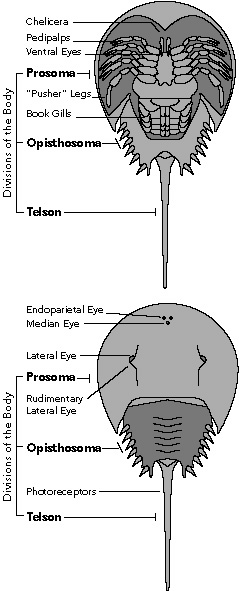
|
Did you know?
- These "living fossils" have been crawling the beaches for 350 million years, before dinosaurs roamed the earth.
- Horseshoe crabs grow by molting their shells some 16 times before reaching sexual maturity.
- Horseshoe crab eggs are an important food source for hungry migratory birds, especially in the mid-Atlantic region.
|
|
The Horseshoe Crab
| Common name: |
Horseshoe crab, Limulus polyphemus |
| Class: |
Arthropod, a large group of animals that have legs with several joints and a body divided into two or more parts. |
| Range: |
The American horseshoe crab is found from Maine to Mexico and throughout Florida. The largest concentration in the world is found in the Delaware Bay region. |
| Anatomy: |
Shaped like a horseshoe with a long, spike rudder-tail, the horseshoe crab sports compound lateral eyes used primarily for finding mates, five additional eyes that orient it to lunar cycles by detecting the UV light of the sun and moon, "pusher" legs for shuffling along the bay bottom, and book gills for swimming and breathing oxygen. |
| Diet: |
Horseshoe crabs dine on phytoplankton, marine worms and clams. |
| Spawning: |
Spawn on beaches in protected bays and coves, mostly in spring and summer on evening high tides during full and new moons. Females typically "tow" smaller males ashore to fertilize eggs, deposited in dense clusters of about 2,000 in shallow pits near the high-water mark. |
| Lifespan: |
Average of 14 to 20 years. |
| Medical uses: |
Pharmaceutical companies use horseshoe crab blood in testing vaccines to ensure that their products are free of bacterial contamination. No other test works as easily and reliably. A reactive agent in the crab's blood known as LAL, or limulus amoebocyte lysate, screens for the presence of endotoxins, which can survive sterilization and cause harmful reactions in humans. Horseshoe crabs are harvested by hand and by trawl, and transported in refrigerated trucks to laboratories, where up to 30% of their blood is removed. The animals typically regain their blood volume in about a week after being returned to the water. Chitin from the horseshoe crab's shell is used for burn wound dressing and suture filament. |
| The next time you roll up your sleeve for a shot, thank the lowly horseshoe crab. The copper-blue blood of these helmet-clad mariners is used by drug companies to test vaccines for the presence of harmful endotoxins. |
Sources: www.horseshoecrab.org, Florida Marine Research Institute
|





